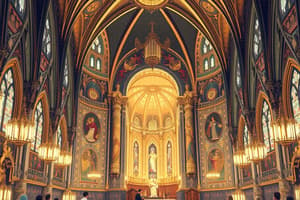Podcast
Questions and Answers
The Priest can never adapt the Entrance antiphon as an introductory explanation.
The Priest can never adapt the Entrance antiphon as an introductory explanation.
False (B)
The faithful always recite the Entrance antiphon.
The faithful always recite the Entrance antiphon.
False (B)
The Introductory Rites are always omitted in certain celebrations combined with Mass.
The Introductory Rites are always omitted in certain celebrations combined with Mass.
False (B)
The Priest's absolution is a substitute for the Sacrament of Penance.
The Priest's absolution is a substitute for the Sacrament of Penance.
The blessing and sprinkling of water always take place after the Penitential Act.
The blessing and sprinkling of water always take place after the Penitential Act.
The Kyrie Eleison is only sung during the Eucharistic Prayer.
The Kyrie Eleison is only sung during the Eucharistic Prayer.
The ministers reverence the altar with a slight bow.
The ministers reverence the altar with a slight bow.
The Entrance antiphon is always recited by the Priest himself.
The Entrance antiphon is always recited by the Priest himself.
The purpose of the Entrance is to ensure the efficacy of the Sacrament of Penance.
The purpose of the Entrance is to ensure the efficacy of the Sacrament of Penance.
The Penitential Act is always part of the Introductory Rites.
The Penitential Act is always part of the Introductory Rites.
Flashcards are hidden until you start studying
Study Notes
The Rite of Peace
- The Rite of Peace signifies the unity of the Body and Blood of the Lord in the work of salvation.
- The faithful express to each other their ecclesial communion and mutual charity before communicating in the Sacrament.
- The manner of giving the actual sign of peace is to be established by the Conferences of Bishops according to the culture and customs of the peoples.
The Fraction of the Bread
- The Fraction of the Bread signifies that the many faithful are made one body by receiving Communion from the one Bread of Life, which is Christ.
- The fraction or breaking of bread is begun after the sign of peace and is carried out with proper reverence.
- This rite is reserved to the Priest and the Deacon.
The Rite of Communion
- The Communion Chant is sung to express the spiritual union of the communicants by means of the unity of their voices.
- The singing is prolonged for as long as the Sacrament is being administered to the faithful.
- If there is to be a hymn after Communion, the Communion Chant should be ended in a timely manner.
The Priest's Preparation for Communion
- The Priest prepares the entire Eucharistic Action, signifying that the many faithful are made one body.
- The Priest pronounces the invitation to the prayer, and all the faithful say the prayer with him.
The Fraction and Communion
- The fraction or breaking of bread is begun after the sign of peace.
- The Priest breaks the Bread and puts a piece of the host into the chalice to signify the unity of the Body and Blood of the Lord.
- It is most desirable that the faithful receive the Lord's Body from hosts consecrated at the same Mass and partake of the chalice.
Studying That Suits You
Use AI to generate personalized quizzes and flashcards to suit your learning preferences.




